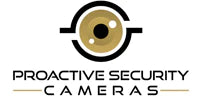A security camera systems' main goal is to prevent criminal activity, however they can also be used as tools that law enforcement use to aid in the capture of criminals. Crime can happen at any time during the day or night, and for that reason our cameras need to be able to perform not only in the day light but also in pitch black darkness.
A cameras' solution to this problem is through the use of Infrared, or IR for short. When infrared is installed on a camera it produces a light just outside the range that humans can see in the spectral range between 700 and 1,000 nm. The cameras are sensitive to this light and will be able to see it illuminating the area, or in other words, they have a built in flash light that only they can see.
Modern security camera systems will produce a color image during the day, and in well lit areas. They have a little light sensor built in which allows them to know when the ambient light drops below a certain level which causes the camera to automatically switch the image over to black and white from color as well as turn on the infrared. The image turns black and white because an IR filter physically slides over the lens, which allows the camera to see the infrared. It's a dual purpose action because details are easier to make out in a black and white image, and turning the image black and white will allow the infrared to have a larger impact on the quality of the image.
People expect a camera to be able to see at night everything it can see during the day, which simply isn't possible. Earlier, I mentioned that IR night vision to a camera is like “a built in flash light that only they can see.” This is actually a really good analogy for the reason I stated earlier but also because if you take a flash light and go into a dark area you will see a concentrated beam wherever you point the flash light, and it will gradually get darker the further away from the center of the light. With a camera it works the same way. If the camera has a 100 degree field of view during the day, you can be sure that it will not get anywhere close to that at night time. So, if you have an area that you want to keep an eye on, make sure it's as close to the center of field of view as possible.
Installing a security camera isn't necessarily difficult but there are some common mistakes that can be avoided with just a little bit of knowledge. The most common mistake I see is the IR from the camera reflecting off of an object that's too close to where the camera was mounted. The infrared will bounce back towards the camera and just completely wash out the image at night time. The two most common instances of that happening is when installing a camera on a home underneath the eave of the house, people will often catch the lip of the house itself. If the IR's get caught on any part of that lip it will cause a ghosting or hazing over the image. The remedy is to install a junction box onto the camera which will drop it below that eave. The second instance is when people are adjusting the camera within its' housing and they adjust the camera too far down, causing the IR's will literally reflect off of the camera itself. It will cause a very similar ghosting/hazing washed out look to the video. Adjusting the camera up within the housing will elevate this problem.
Shop Surveillance Cameras - Click Here
Read more blogs - Click Her


